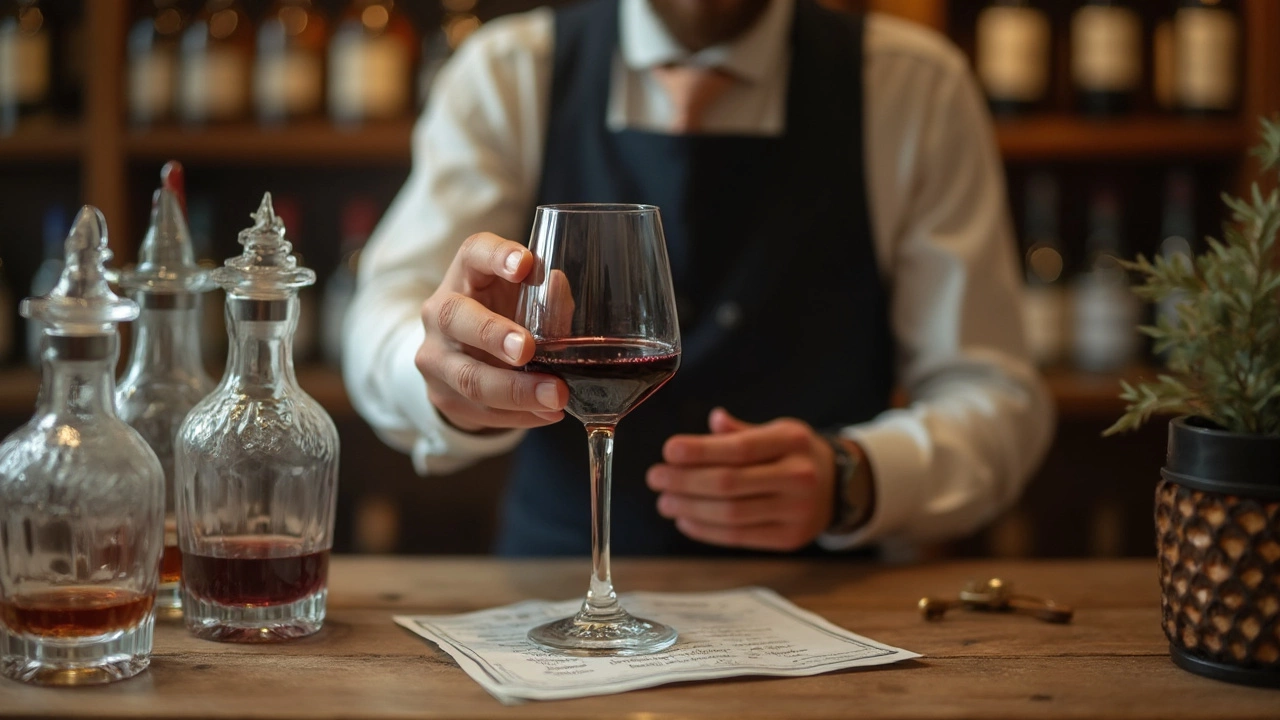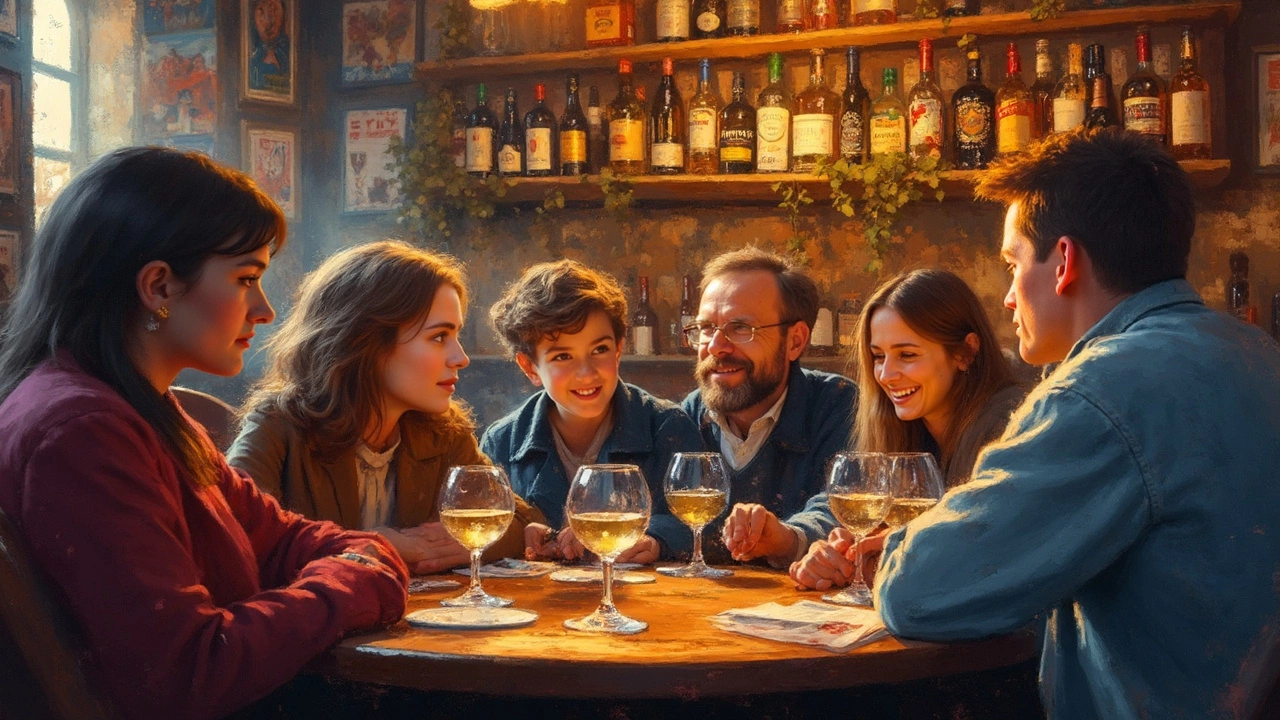The Lowdown on Wine Tasting: The Process Explained
 Mar, 30 2025
Mar, 30 2025
Wine tasting might sound fancy, but it's more about discovery than pretension. If you're new to it or trying to sharpen your skills, you're in the right place. This isn't just about swirling and sniffing; there's a bit of science and a whole lot of enjoyment involved.
First things first, pick your setting wisely. Ever tried enjoying a fine Chardonnay in a noisy place? Not happening. Find somewhere quiet with good lighting. You want to see the wine clearly and not be distracted by chatter or clatter.
Grab a glass that narrows at the top. There's a reason they don’t serve wine in coffee mugs! The shape helps trap the aromas, and that's a big part of what makes tasting wine so special. Next time you're at a gathering, bring this little tidbit up, and you'll sound like a pro.
- Getting Started with Wine Tasting
- The Art of Looking at Wine
- Unlocking Wine's Aromas
- Savoring the Flavors
- Tips for a Memorable Tasting Experience
Getting Started with Wine Tasting
Alright, so you're ready to dip your toes into the world of wine tasting. Good choice! First step is knowing that it's not just for wine snobs or experts. Anyone can do it, and it's a great way to explore new flavors and have some fun.
The first thing you'll need is the right tools. A suitable glass is your best friend here. Go for a stemmed glass that narrows at the top. This helps you catch all those wonderful aromas without warming up the wine with your hands.
Temperature matters more than you might think. Reds are best at room temperature, around 16-18°C (that's 60-65°F). Whites love it cooler, closer to 8-12°C (about 46-54°F). Too warm or too cold, and you're missing out on flavors.
Pour just enough wine to cover the bottom of the glass, about a third full. This gives you room to swirl without spills and helps concentrate those smells.
Now, setting is everything. Look for a place with good lighting and no distracting fragrances. You want to focus on the aromas and flavors. A strong perfume or cooking smells can mess with your senses.
If you're planning a tasting with friends, a tasting order is key. Go from lightest to heaviest: start with sparkling, move to whites, then rosés, and finish with reds. A random order might confuse your palate, making it hard to enjoy each wine's unique notes.
- Gather a variety of wines for comparison.
- Keep some water and plain bread or crackers nearby to cleanse your palate.
- Jot down your impressions. You're not required to write a novel—but noting 'fruity' or 'spicy' goes a long way.
Getting started with wine tasting is simple once you know the basics. And trust me, with a little practice, you'll start picking up details you never noticed before.
The Art of Looking at Wine
Alright, so you've got your wine glass ready. What's next? Before you drink, take a good look at what's inside. There’s a whole story that unfolds just from observing the wine. It's not just about admiring the color; it's like getting the first glimpse into what you're about to taste.
Start by holding the glass against a plain, light background. This lets you see the wine's true color without any distractions. The color can tell you a lot about the wine's age and grape variety. For instance, a deep ruby red often suggests a younger, bold red wine like a Malbec, while a brownish tint might hint at an older vintage.
"The color and clarity of wine offer the first clues to its identity. This is a vital initial step in the tasting process," says wine expert James Halliday.
Check out the wine's clarity too. A clear and bright appearance usually means the wine is in good shape. If it looks hazy, it might not be well-filtered or something could be off. Observe how the wine moves in the glass, known as its viscosity or “legs.” If they take their time dripping down, you might be dealing with higher alcohol content or sugar in the wine.
| Attribute | Indication |
|---|---|
| Color | Age and grape variety |
| Clarity | Winemaking process |
| Legs | Alcohol and sugar level |
When you break it down into these steps, the wine tasting process is all about noting these visual clues before diving into flavors. By mastering the art of looking at your wine, you set the stage for a much richer tasting experience.

Unlocking Wine's Aromas
Okay, so here's where the fun starts—sniffing out all those cool aromas. You might think wine just smells like, well, wine, but there's a whole world of scents packed into that glass.
First, give your wine a good swirl. This isn't just to look fancy; it's about releasing the aromas so you can catch them in the narrow part of the glass. Pop your nose right in there, and take a gentle sniff. You'll be surprised at the variety you might pick up.
People often talk about wine smelling like fruit, spices, or even flowers. This comes from the grapes and the aging process. For example, a Chardonnay might give off hints of apple or butter, while a Cabernet Sauvignon could lean more towards black cherry or even eucalyptus.
But how on earth do you identify these? Practice is key. Try different wines and pay attention to the different elements you smell. Soon enough, you'll start pinpointing specific aromas without even thinking about it.
- Primary Aromas: These come from the grapes themselves—think of fruit and floral notes.
- Secondary Aromas: These are from the fermentation process, like butter or cream nuances.
- Tertiary Aromas: Emanating from aging, they can include nutty or roasted smells.
It's like piecing together a scent puzzle, where each sniff adds a new bit of information. And remember, wine tasting is personal, so trust your nose and what it picks up. You might impress yourself with your newfound skills!
Savoring the Flavors
Alright, you've swirled, sniffed, and now it's time for the best part—tasting. This is where your tongue gets to have some fun. It's not just about taking a sip and gulping it down. There's a whole flavor journey waiting for you.
Start with a small sip. Let it sit on your tongue. Notice the initial burst of flavors. Wines often have what's called a 'flavor profile,' a combination of tastes that might include fruits, spices, or even earthy notes. Some wine flavors you'll easily recognize, like cherry or vanilla, while others can surprise you, like tobacco or leather. I know, leather doesn't sound tasty, but trust me, in wine, it works.
Swish it around a bit. This helps you catch all the different tastes. As you do, think about how the flavors change—some might fade, and others might get stronger. This is part of what makes wine tasting so exciting—it's always a bit of an adventure!
Take notice of the wine’s 'body'. This refers to how thick or thin the wine feels in your mouth. A rich, powerful wine would be full-bodied. Ever heard someone say 'this wine has legs'? They're talking about the trails that form on the glass when you swirl it, which can hint at the body and alcohol content.
Finally, notice the aftertaste, or 'finish'. It's like the encore of a concert. A long finish with lingering flavors is usually a good sign of a high-quality wine. You'll find some wines dance on your palate well after you've swallowed.
- Pro tip: If you’re tasting multiple wines, start with lighter ones like a white or rose and move to deeper reds. Your taste buds will thank you!
- Keep some palate cleansers handy like plain bread or mild cheese, so each tasting starts fresh.
Tasting wine is a skill that builds over time, and every session adds to your know-how. Cheers to exploring wine flavors and enjoying each unique sip!

Tips for a Memorable Tasting Experience
If you want your wine tasting session to be more than just another glass of wine, there are a few insider tricks to keep in mind. It's about making it a holistic experience that sticks with you beyond just the sip itself.
Start with a clean palate. Spicy wings or garlic bread aren't great prep for tasting Pinot Noir. A simple cracker or some water can help reset your taste buds. It’s amazing how much a strong flavor can mask the subtleties in wine.
Don't forget about the temperature of your wine. Serving white wines too cold or reds too warm is like going to the beach in a tux—it's just not right. Whites are best chilled, but not freezing, while room temperature is generally good for reds.
Take your time. Sipping and quickly swallowing is like shaking hands with someone and not getting their name. Allow the wine to linger in your mouth for a few seconds. Let your tongue savor all the flavors before you slurp it down.
- Eyes first: Appreciate the color and clarity of the wine. Swirl it slightly to observe its 'legs' (the drips that run down the glass). It’s a good starting point even before your taste buds take over.
- Nose knows: Smell is a big part of taste. Give a quick sniff to catch those initial aromas, then a long luxurious nose dive to detect subtle notes.
- Savor slowly: Let it roll over your tongue. Notice how it shifts from fruity to spicy, to maybe even floral. Each sip can change, offering new surprises.
Moreover, keep notes. Bringing a small notebook or even using an app can help you track what you liked or didn't. This way, next time you shop for wines, you can skip the guesswork.
If you’re into numbers, consider this: over 12,000 wine-tasting events were held in Australia last year alone. So there’s always an opportunity to practice!
| Wine | Serving Temperature |
|---|---|
| White Wine | 7-10°C (45-50°F) |
| Red Wine | 15-18°C (59-64°F) |
So go ahead, take it slow, savor each drop, and remember—it’s all about enjoying wine in a way that's memorable and fun. After all, it’s not just about what's in the glass; it's also about who you're with and the stories that unfold with each bottle.